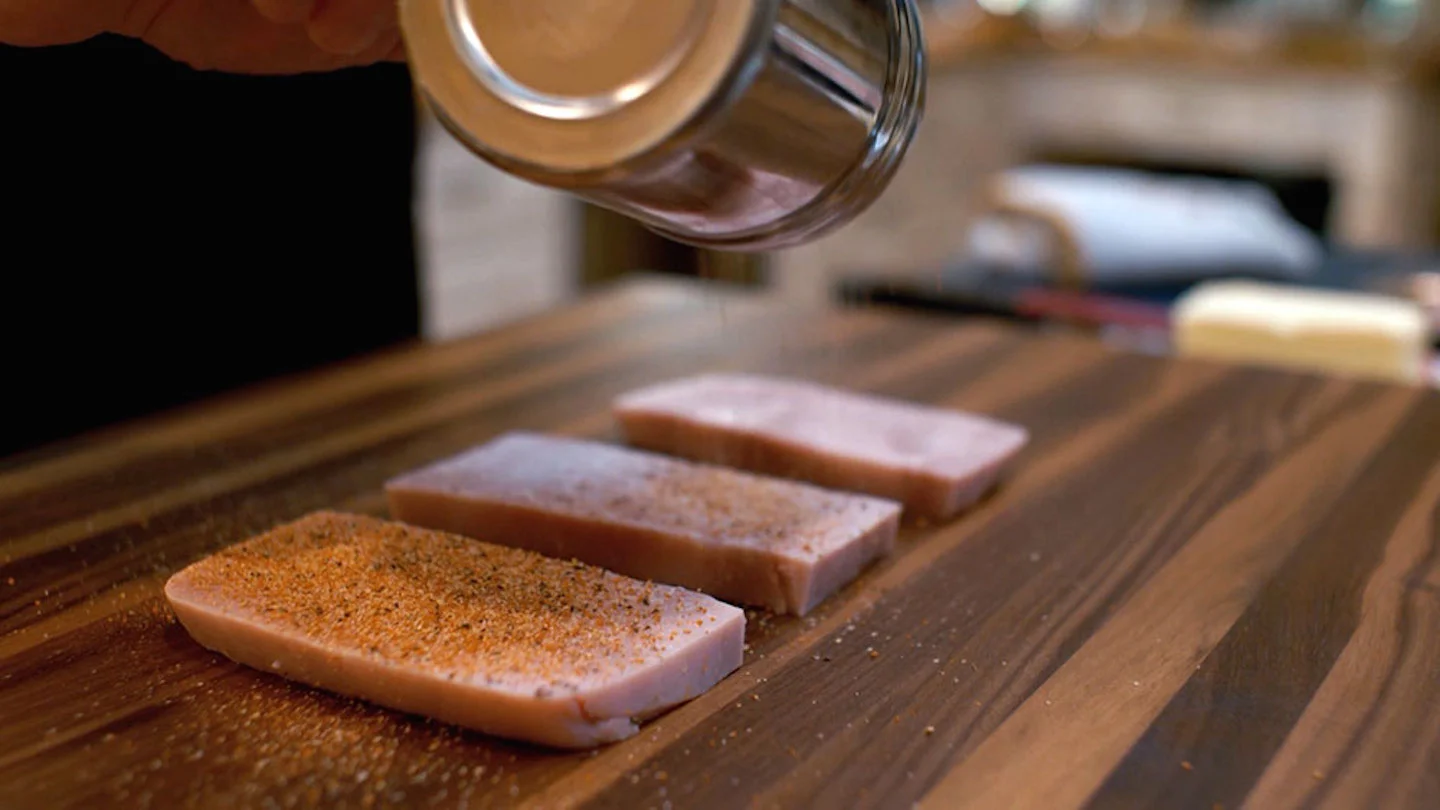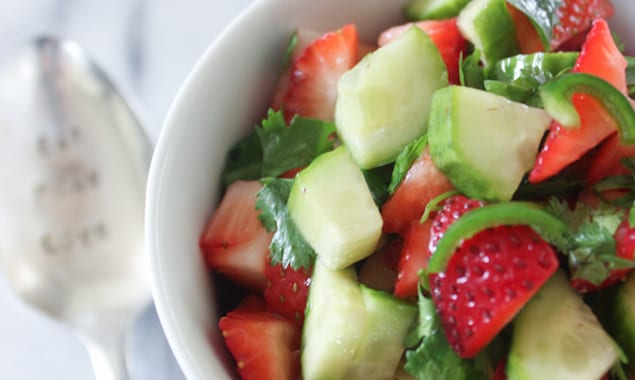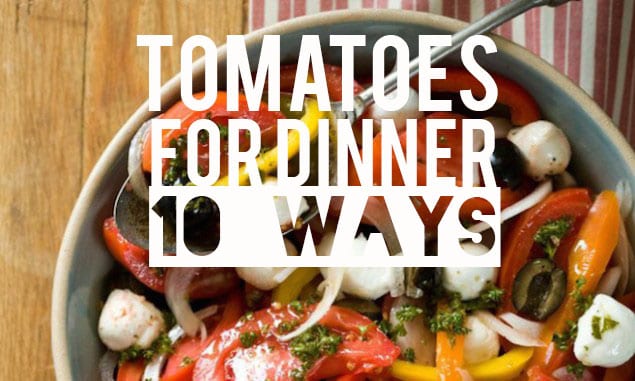A recovering teacher and editorial intern for Honest Cooking, Maya…
If you do these things, perhaps don’t. Honest Cooking brings you the do’s and don’ts of dining out. Follow these tips and for a more enjoyable evening for all, your server, too.
By Maya Dangerfield

I, like most people, enjoy eating out. It’s a delicious treat to visit a restaurant—a most welcome reprieve from staring at an empty fridge and wondering what can be made with Greek yogurt and a flaccid stem of broccoli (nothing, to say the least). As a food writer I pride myself on being knowledge about food; though I hesitate to call myself a foodie as the term is loaded with a fair amount of condescension and well deserved eye-rolling. I, like most writers in New York City, double as a server (thanks student loans). After researching the latest gastronomic happenings for Honest Cooking, I spend most nights working at a busy Brooklyn restaurant. Both jobs are beneficial—one teaches me to be a discerning, conscientious, and responsible consumer—the other, unending patience. As a writer with service experience I’ve learned an import, yet perplexing lesson: People who write about food often know nothing about food service.
In an era where people can (without prompting) spout off the dangers of genetically modified foods and recite the history of the organic food movement between 2004-2014 ( psst, nothing happens), foodies remain largely ignorant about how restaurants actually work. For some, it remains a mystical combination of magic and good produce. Granted, understanding how chefs queue orders isn’t essential when writing about the latest kale salad; however, when giving tips to consumers about eating out, it’s best to avoid practices that causes nervous breakdowns in restaurant staff. This is why articles like such as this one “Eating Outside Your Home!” are frustrating for food lovers knowledgeable about food service, or indeed any person with reasonable levels of dining etiquette.
Simply put, sometimes writers’ suggestions are utterly ridiculous. From lying about food allergies to requesting off the menu items, these lists can be the perfect guide to bad dining behavior. I’ve taken the time to highlight the ludicrousness of some suggestions in the hopes it encourages diners to disregard ill-advised suggestions. Unless you want to see a server cry,then these tips are for you!
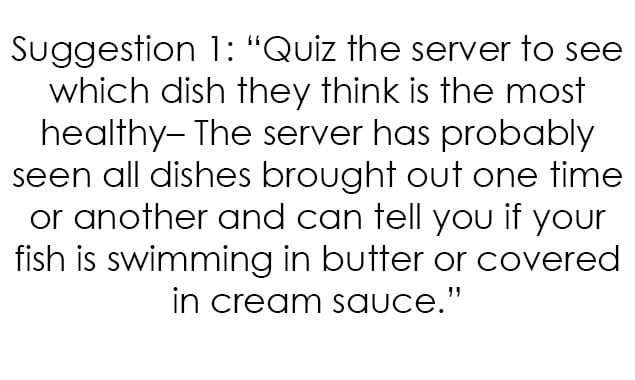 No one likes a quiz. You certainly weren’t fond of them in high school and your opinions haven’t changed since you started paying taxes. Severs are trained to know the menu, lend advice, and help you choose. They are however, not trained to withstand an Inquisition-style questioning about the health benefits of green vs. brown lentils. Rather than having a server explain the health aspects of every dish simply take the time to read the menu yourself and decide what you health goals are. Menus these days are pretty descriptive. They’re cleverly designed to take the guesswork out of what is eventually going to show up in front of you. Don’t like cream—don’t order the trout poached in shallots, cream, and garlic. Want to eat light—go with the salad, not the twice smothered fried pork chops (I don’t know if this menu item exists, but it should.) It’s best not to ask your server about the nutritional value of every item on the menu, simply put, they are not nutritionists. Most servers are juggling eight to ten tables at a time so ten minutes at your table answering questions that only you know the answers to means other tables are being neglected. Keep your questions targeted and brief. If you find your way straying into a Portlandia sketch, than stop immediately.
No one likes a quiz. You certainly weren’t fond of them in high school and your opinions haven’t changed since you started paying taxes. Severs are trained to know the menu, lend advice, and help you choose. They are however, not trained to withstand an Inquisition-style questioning about the health benefits of green vs. brown lentils. Rather than having a server explain the health aspects of every dish simply take the time to read the menu yourself and decide what you health goals are. Menus these days are pretty descriptive. They’re cleverly designed to take the guesswork out of what is eventually going to show up in front of you. Don’t like cream—don’t order the trout poached in shallots, cream, and garlic. Want to eat light—go with the salad, not the twice smothered fried pork chops (I don’t know if this menu item exists, but it should.) It’s best not to ask your server about the nutritional value of every item on the menu, simply put, they are not nutritionists. Most servers are juggling eight to ten tables at a time so ten minutes at your table answering questions that only you know the answers to means other tables are being neglected. Keep your questions targeted and brief. If you find your way straying into a Portlandia sketch, than stop immediately.
 Never do this. It’s not only downright dishonest, it trivializes people who actually have food allergies. It’s hard enough getting respect after Ron Swanson of Parks and Recreation fame notes the only real allergies are cowardice, weak-willed men, and hazelnuts. The food industry takes allergies seriously—it’s the difference between a good dining experience and a diner gasping for air on the ground, as a harried server rushes forward to stab them with an EpiPen. Rarely has a hospital visit yielded positive Yelp reviews. It’s uncommon for adults to have a soy allergy. While it’s more common to have a dairy allergy, the condition only affects .2-.4 percent of the American public. It is also rare to have a corn allergy. If you have all three, you’re a unicorn and it is going to be very difficult to accommodate you as a diner. Not to say it is impossible, but let’s not request the server to have the kitchen franticly throw together a menu item on the spot that will not be as satisfying for you anyway. What is more common is intolerance to a particular item. Don’t know the difference between an allergy and intolerance? Allergies involve the immune system overreacting to an element, intolerances are when your tummy hurts. (not to take intolerances lightly, they are just as uncomfortable for the afflicted) One is solved by strong medication, the other by avoidance and pepto-bismol.
Never do this. It’s not only downright dishonest, it trivializes people who actually have food allergies. It’s hard enough getting respect after Ron Swanson of Parks and Recreation fame notes the only real allergies are cowardice, weak-willed men, and hazelnuts. The food industry takes allergies seriously—it’s the difference between a good dining experience and a diner gasping for air on the ground, as a harried server rushes forward to stab them with an EpiPen. Rarely has a hospital visit yielded positive Yelp reviews. It’s uncommon for adults to have a soy allergy. While it’s more common to have a dairy allergy, the condition only affects .2-.4 percent of the American public. It is also rare to have a corn allergy. If you have all three, you’re a unicorn and it is going to be very difficult to accommodate you as a diner. Not to say it is impossible, but let’s not request the server to have the kitchen franticly throw together a menu item on the spot that will not be as satisfying for you anyway. What is more common is intolerance to a particular item. Don’t know the difference between an allergy and intolerance? Allergies involve the immune system overreacting to an element, intolerances are when your tummy hurts. (not to take intolerances lightly, they are just as uncomfortable for the afflicted) One is solved by strong medication, the other by avoidance and pepto-bismol.
 Psst. Industry secret. Restaurants use butter. From your pasta sauce to your perfectly seared steak, butter is in everything. But there’s no maniacal figure in the kitchen cackling widely as they add butter to dishes and wish you ill-tidings during swimsuit season. Chefs are professional perfectionists. They understand how the flavors of a dish work together and how too much, or too little of an ingredient can wreck a dish. Instead of insisting that your items be butter- free it’s best to sit back and let the chef decide the appropriate amount of butter. Eating out is an enjoyable treat, right? Additionally, debates about the healthfulness of butter are roundly circular. No one can really agree which butter, either grass-fed or organic, is better for you, as butter itself is not particularly known for being healthy.
Psst. Industry secret. Restaurants use butter. From your pasta sauce to your perfectly seared steak, butter is in everything. But there’s no maniacal figure in the kitchen cackling widely as they add butter to dishes and wish you ill-tidings during swimsuit season. Chefs are professional perfectionists. They understand how the flavors of a dish work together and how too much, or too little of an ingredient can wreck a dish. Instead of insisting that your items be butter- free it’s best to sit back and let the chef decide the appropriate amount of butter. Eating out is an enjoyable treat, right? Additionally, debates about the healthfulness of butter are roundly circular. No one can really agree which butter, either grass-fed or organic, is better for you, as butter itself is not particularly known for being healthy.
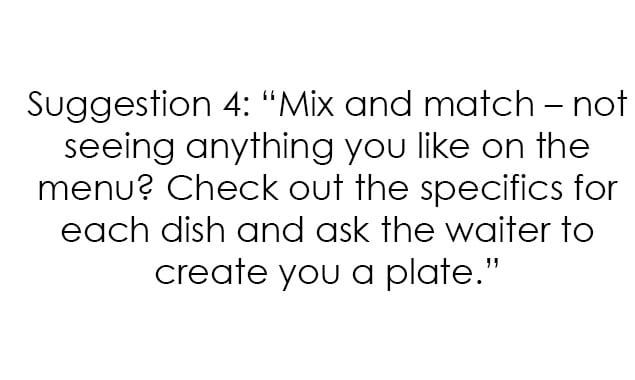 Restaurants are different than your home kitchen. Just look for the professionally trained individual who painstakingly crafted a menu that balances with seasonality and with taste, and who, after preparing a dish gives it to a sever who delivers to you and doesn’t ask for help cleaning up afterwards. That’s a restaurant. Mix and matching works for well for clothes, not so great for restaurants. Not seeing anything you like on the menu? Go to another restaurant. But if you stay know this—more often than not chefs will refuse this request because such preferences endanger kitchen logistics. Kitchens work in stations—the simplest arrangement are stations dedicated to starters, mains, and desserts, with an expediter who calls out orders, and decides which dishes in which order, leave the kitchen. Combining elements of a starter and a main or even asking for a switch between elements in a single category can stall the entire kitchen. Food is grouped by table and stations have to work together to produce items at the same time. So a request to mix and match means your order will take longer and delay the order for other tables whose only crime was ordering after a picky diner.
Restaurants are different than your home kitchen. Just look for the professionally trained individual who painstakingly crafted a menu that balances with seasonality and with taste, and who, after preparing a dish gives it to a sever who delivers to you and doesn’t ask for help cleaning up afterwards. That’s a restaurant. Mix and matching works for well for clothes, not so great for restaurants. Not seeing anything you like on the menu? Go to another restaurant. But if you stay know this—more often than not chefs will refuse this request because such preferences endanger kitchen logistics. Kitchens work in stations—the simplest arrangement are stations dedicated to starters, mains, and desserts, with an expediter who calls out orders, and decides which dishes in which order, leave the kitchen. Combining elements of a starter and a main or even asking for a switch between elements in a single category can stall the entire kitchen. Food is grouped by table and stations have to work together to produce items at the same time. So a request to mix and match means your order will take longer and delay the order for other tables whose only crime was ordering after a picky diner.
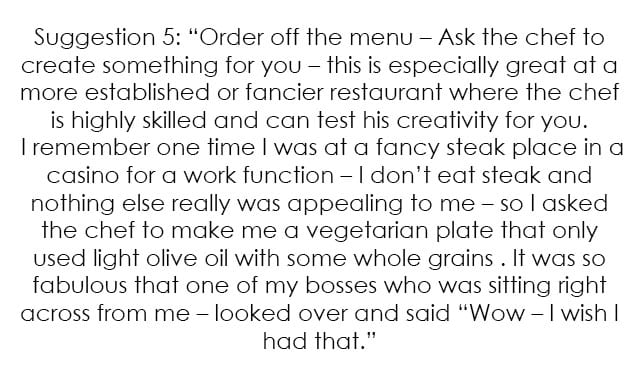 Let’s start at the beginning of this lunacy. Ordering off the menu is an acceptable practice at a small number of restaurants, and is rarely encouraged in most ‘fancier’ establishments. Want something off the menu –stick to industry favorites In-and-Out Burger, Starbucks, or Chipotle.
Let’s start at the beginning of this lunacy. Ordering off the menu is an acceptable practice at a small number of restaurants, and is rarely encouraged in most ‘fancier’ establishments. Want something off the menu –stick to industry favorites In-and-Out Burger, Starbucks, or Chipotle.
Want to sample the chef’s creativity? Be prepared to drop hundreds of dollars on a tasting menu. A tasting menu offers the opportunity for diners to enjoy the creative range of the chef with dishes not found on the menu. Want something special? Be prepared to pay—although most tasting menus hover between $50-200 per person, the price of “having the chef whip up something fancy” depends largely on the chef’s notoriety. Cesar Ramirez’s Brooklyn Fare charges $225 per person, while Thomas Keller’s three star restaurant Per Se begin at $295.
I remember one time I was at a fancy steak place in a casino for a work function – I don’t eat steak and nothing else really was appealing to me.
Go to another restaurant. This is a steak restaurant. They’re really good at steak. In fact, they’re so good at cooking steak, they specialize in it. Finding nothing appealing at a steak restaurant when you don’t eat steak is about as newsworthy as the heliocentric theory.
It was so fabulous that one of my bosses who was sitting right across from me – looked over and said “Wow – I wish I had that.”
I doubt that very much. A plate of boring vegetables served with anemic rice only inspires the awe of senior citizens with sensitive teeth.
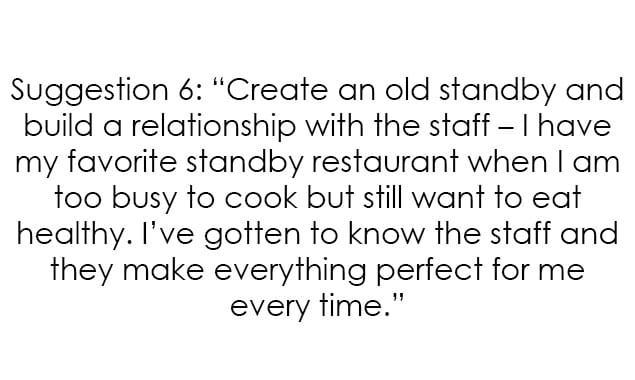 I guarantee the staff hates you. But hey, if you have a routine down with their kitchen, maybe it is not so disruptive after all. However, when you walk in the staff probably says: “There’s that lady who comes to a restaurant and instead of reading the menu, quizzes the staff about every possible combination of food the chef is willing to make. Then she makes up an impressive list of allergies, threatens us with death if butter nears her plate, and loudly bemoans the lack of vegetarian options at a steak restaurant. Please, take my table.”
I guarantee the staff hates you. But hey, if you have a routine down with their kitchen, maybe it is not so disruptive after all. However, when you walk in the staff probably says: “There’s that lady who comes to a restaurant and instead of reading the menu, quizzes the staff about every possible combination of food the chef is willing to make. Then she makes up an impressive list of allergies, threatens us with death if butter nears her plate, and loudly bemoans the lack of vegetarian options at a steak restaurant. Please, take my table.”
A recovering teacher and editorial intern for Honest Cooking, Maya began her journalism career at Greatist.com. A food lover who never misses dessert, she is also a passionate sports enthusiast. Currently Maya freelances for FoodmakerMedia and copywrites for Techturized. Her writing has been published for Greatist.com, Shape.com, and The Washington Post.

